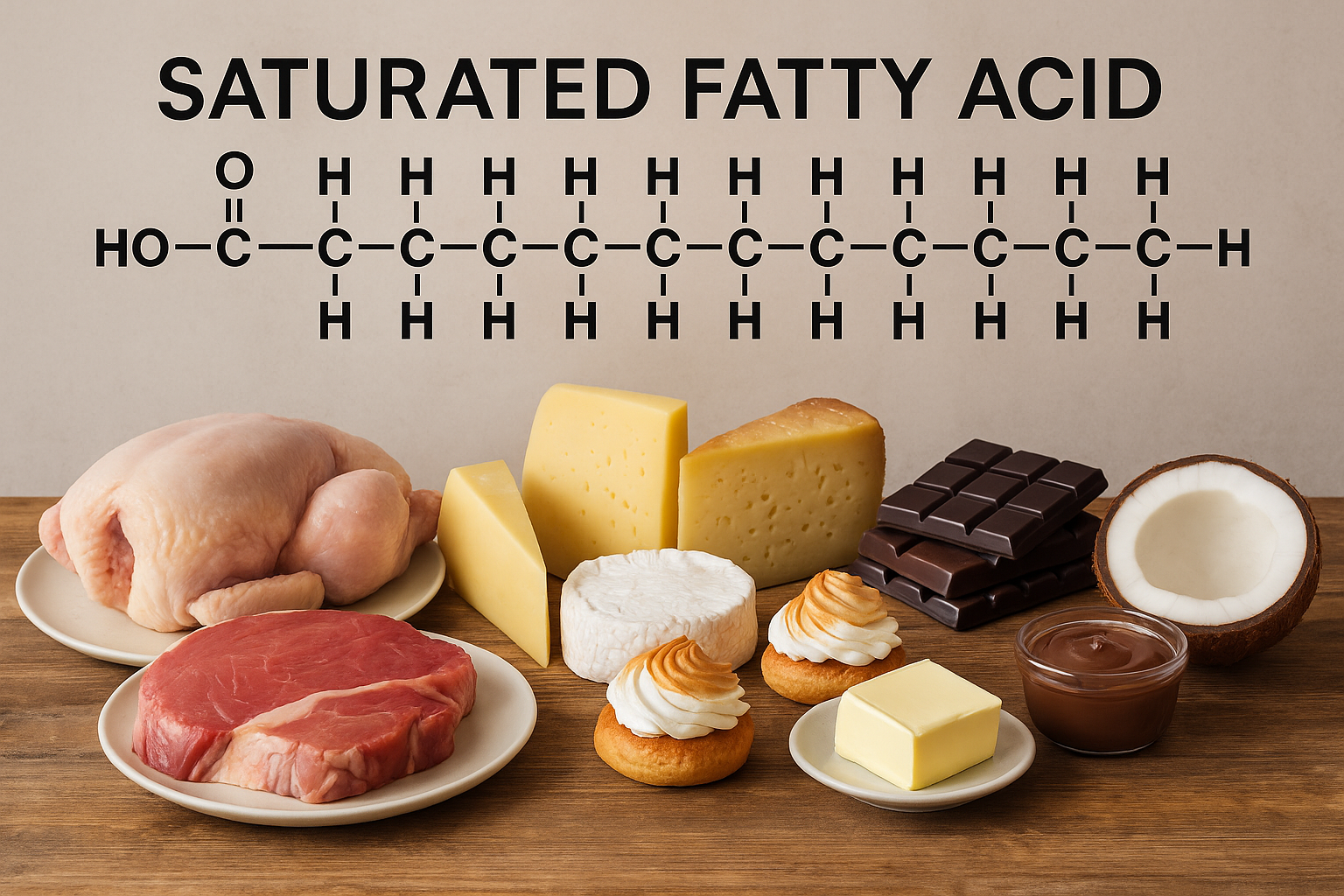I bet fats are the macronutrient you’ve heard the most myths and conflicting opinions about. Your aunt is probably trying to eliminate them completely from her diet to lose weight. Your cousin goes from one ketogenic diet to another, proclaiming their benefits at every family dinner. And your coworker is convinced that using plenty of olive oil daily is the key to longevity.
If you’re feeling totally confused by all this information and find yourself looking for an excuse to escape the room every time the topic comes up, perhaps you might find this article useful.
So let’s clear things up and explore what fats are from a biochemical perspective, and in particular, why there’s still such a heated debate about saturated fats.
What Are Fats?
Fats (or lipids) are a family of very diverse molecules united by one characteristic: they are insoluble in water. Some of them have only a water-repelling part and another soluble part like the phospholipids present in our cell membranes.
The Most Important Lipids in Nutrition
98% of dietary fats are present as triglycerides (or triacylglycerols). You’ve surely heard of them and measured them in your blood tests.
But what exactly are they? And, most importantly, are they all the same?
They are basically molecules that bind together 3 fatty acids thanks to a glycerol.
So we can say that the vast majority of fats we get from food are fatty acids. The remaining 2% consists of other insoluble molecules, like phospholipids and sterols. But I will talk more about this last group in another dedicated article, particularly about cholesterol and phytosterols and their effects on lipid metabolism.
Fatty Acids: Energy-Packed Chains
What unites all fatty acids:
They are very simple molecules, containing only 3 elements: carbon (C), hydrogen (H) and oxygen (O)
They constitute the main energy reserve in all living organisms
They are chains of varying length
But Do We Need Them?
When we talk about any nutrient, macro- or micro-, the first two questions we must ask are whether we need it for physiological functions and whether our body can produce it.
Yes, we need fatty acids because:
They are part of phospholipids, the main component of biological membranes in all our cells and some intracellular organelles
They are precursors of inflammatory mediators
They are necessary for structural adipose tissue (like the fatty capsule that surrounds the kidneys)
They constitute our main energy reserve
Lipid droplets transport fat-soluble vitamins
Yes, our body can synthesize all fatty acids (and all lipids in general) it needs to perform these functions except for two essential ones:
α-linolenic acid (ALA), the precursor of the omega-3 fatty acid series
linoleic acid (LA), the precursor of the omega-6 series
Only these two fatty acids are technically essential and we must necessarily introduce them through diet. We are capable of producing all other lipids from carbohydrates, amino acids (proteins), or from ALA and LA.
Do Fats Make You Fat?
The short answer is no.
What makes you gain weight is any excess macronutrient that is introduced into an organism and not used.
However, there are some reasons why people following a high-fat diet tend to gain weight more easily:
One gram of fat provides 9 kcal, while one gram of carbohydrates and proteins provides about 4 kcal, so high-fat foods have higher caloric density
In a Western diet, most fats come from animal foods, or from plant foods produced through extraction (like oils), so both don’t contain fiber, consequently providing less satiety
Types of Fatty Acids
You’ve surely heard about saturated and unsaturated fatty acids. These are essentially two main categories, to which we add a subcategory of trans fatty acids.
Trans fatty acids are unsaturated fats that have been industrially modified through hydrogenation to give them some physical characteristics of saturated fats.
Saturated Fatty Acids (SFA)

Saturated fatty acids (SFA) are the “rigid rods” of the lipid world. Their name comes from the fact that all carbon atoms are “saturated” with hydrogen.
This linear structure allows molecules to pack tightly together, like pencils in a case, which is why saturated fats are solid at room temperature.
Consequently, when saturated fats are incorporated into cell membranes, they make them less fluid and more rigid. In small amounts this can be beneficial, providing structural stability, but excess can compromise the functionality of membrane proteins and alter cellular permeability.
Saturated fats are found mainly in:
Animal foods: red meat, white meat (poultry), processed meats, whole dairy products, butter, lard
Tropical vegetable oils: palm oil, coconut oil, cocoa
Industrial products: cookies, snacks, packaged sweets, creams and desserts containing butter, dairy or tropical fats
Other vegetable oils: still contain a percentage of saturated fats (for example, olive oil contains 15%)
Are Saturated Fats Dangerous for Health?
The association between SFA and coronary heart disease was first reported in observational studies more than 50 years ago. The “father of the Mediterranean Diet” Ancel Keys and his colleagues found a strong correlation between the percentage of energy from SFA and cardiovascular disease incidence in the Seven Countries Study.
It was observed more than 30 years ago that this correlation was largely due to an association between SFA consumption and blood concentration of LDL cholesterol (the “bad” one).
Since then, conflicting results have been reported from multiple prospective observational studies and, more recently, from systematic reviews and meta-analyses. However, there are several confounding factors that may contribute to these inconsistencies.
For this reason, the WHO conducted the most important systematic review and meta-analysis to date, analyzing 112 publications related to SFA with a total of almost 3,700,000 participants.
These are the results:
Higher SFA intake was associated with increased mortality
Coronary heart disease (CHD) and mortality was reduced when 5% of total energy from SFA was replaced with polyunsaturated fats (PUFA), monounsaturated fats (MUFA) or slow-digesting carbohydrates (rich in fiber)
Higher tissue measures of total SFA were associated with greater incidence of CHD and type 2 diabetes
For this reason the guidelines from WHO and major dietary associations suggest not exceeding 10% of daily energy from SFA. This means that if we take an average person who consumes 2000 kcal/day, they should not exceed 200 kcal, which equals 22g of SFA per day (one gram of fat contains 9 kcal).
Not All Saturated Fatty Acids Are Equal
The effects of different SFA on our body vary significantly based on their chain length (the number of carbon atoms).
Short-chain SFA (or SCFA) are those with between 2 and 5 carbon atoms (C2-C5). They are particularly beneficial at the colon level where they are produced by the intestinal microbiota in response to certain fibers.
Medium-chain SFA (or MCFA) - between 6 and 11 carbon atoms (C6-C11).
Long-chain SFA (or LCSFA) - between 12 and 18 carbon atoms (C12-18).
A 2023 systematic review reports that most studies have found that long-chain SFA are correlated with increased cardiovascular risk, while short- or medium-chain ones more likely have beneficial or neutral effects. However, the results are not completely consistent and more studies on the topic are needed. Additionally, researchers have noted the difficulty of distinguishing between individual SFA because most food sources contain multiple types of them.
SFA, Inflammation and Cardiovascular Disease
Researchers who developed the Dietary Inflammatory Index (DII), screening 6,500 scientific studies and analyzing about 2,000 articles on the correlation between foods and their macro- and micronutrients on pro-inflammatory and anti-inflammatory markers, found a clear pro-inflammatory effect that increases with increasing total fat and saturated fat intake in particular.
Subsequently, there have been several studies that analyzed the correlation between DII and various diseases and pathological conditions. This meta-analysis, for example, found subjects in the highest DII category (indicating a pro-inflammatory diet) compared to the lowest showed a 36% increase in the risk of incidence and mortality from cardiovascular diseases.
It must be kept in mind that naturally it’s not the only inflammatory parameter and DII is balanced by anti-inflammatory nutrients and foods, so the complete diet must always be considered.
Foods Rich in SFA and Protective Dietary Patterns
So what should we do in practice? Equip ourselves with apps that precisely calculate the types of saturated fats we consume and record every single meal? This would probably lead us to nervous exhaustion after just a few days.
The solution is much simpler. Diet should always be considered as a whole of many components, and we now have certainty about dietary patterns that help reduce not only cardiovascular risk but also all-cause mortality.
One of these is the original Mediterranean Diet which was based on minimally processed plant foods and included few animal foods, mainly fish. In fact, an important 2018 meta-analysis concluded that among the protective components of the Mediterranean Diet, negatively associated with all-cause mortality were cereals, fruits and vegetables; while greater consumption of meat and dairy was correlated with increased risk.
Additionally, vegetarian and vegan diets based on whole foods have also been associated by several important meta-analyses with reduced concentrations of total cholesterol, LDL and apolipoprotein B, consequently with reduced risk of atherosclerosis and cardiovascular diseases.
Key Takeaways
Fats don’t directly make you fat: excess calories from any macronutrient can lead to weight gain, but high-fat foods are calorie-dense and less satiating.
Only two fatty acids are truly essential: α-linolenic acid (ALA) and linoleic acid (LA), every other lipid your body can make from other nutrients.
Higher saturated fat intake is associated with increased mortality and coronary heart disease based on extensive research.
Saturated fats should be limited to 10% of daily calories (about 22g per day for a 2000-calorie diet) based on WHO guidelines and major dietary associations.
Not all saturated fats are equal: short and medium-chain saturated fats may be neutral or beneficial, while long-chain ones are associated with cardiovascular risks.
Research shows a clear pro-inflammatory effect that increases with higher total fat and saturated fat intake in particular.
Focus on dietary patterns, not individual nutrients: the Mediterranean diet, vegetarian and vegan diets based on whole foods consistently show the best health outcomes.
Discover more:
The Science of Healthy Eating #1: How to Follow a True Mediterranean Diet
